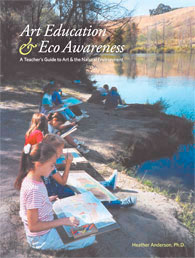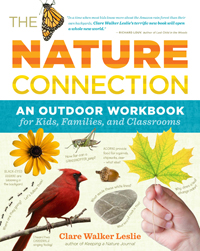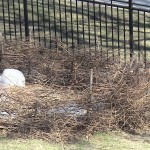The spring has been busy and interfered with my blogging, but there are so many wonderful things happening in eco-art education to share! I attended the NAEA’s annual conference in March in New York City, and saw a number of sessions focused on environmental art education. The best news is that there is a group of scholars coming together to develop this area, led by Tom Anderson and Anniina Suominen Guyas at Florida State University. They have started a new website, Earth art education [http://www.eartharteducation.com/] to act as a nexus for research and advocacy into environmental art education. I’m happy to have been asked to sit on the editorial board of their new journal, Earth Education, and look forward to contributing to the content of the website as well. Please consider sending papers to the journal as we’d love to read them!
Get outside and draw!
I had the pleasure recently of attending a workshop led by naturalist Clare Walker Leslie, who is a prolific artist and author. Clare is a passionate proponent of art-based nature journalling, well-evidenced in her many journals. Seeing her journals is a delight – they are rich with drawings of the natural world, observations, and connections to her experiences. Her drawing style is beautiful – in some cases, quick and gestural to capture the shape of a bird before it flies off into the bush; in others, detailed, well-worked watercolours or coloured pencil drawings created in her studio from outdoor sketches and field guides. She spends a lot of time in classrooms with students, encouraging them to use drawing (or mark-making, as she prefers to call it) as a way to closely observe the flora and fauna around them – an important step towards developing their ecological literacy. Clare delivered three workshops in Toronto, including one at the Master of Teaching Environmental Education conference at OISE. It was refreshing to get outside – yes, even in a cold Ontario winter – just to draw, and to be reminded of the power of journaling as an ongoing learning activity for learners of all ages.  For more info on Clare, or to order one of her books, please visit her website at: Â
Art Education & Eco-Awareness
As part of a conference I presented at in the fall (All Hands in the Dirt, at Evergreen Brick Works) I was asked to present on how to keep students making art outside when the weather turns cold. That day we did some outdoor stenciling, but it reminded me of the power of taking art learners of all ages outside year-round to learn from the natural world. A colleague in the States, Heather Anderson, has written a new book on just this topic that’s worth a look: Art Education & Eco-Awareness: A Teacher’s Guide to Art and the Natural Environment. This resource is a compilation of art lessons on land, water, sky, plants and wildlife, all accompanied by colour illustrations of professional artists’ work on these themes and exemplars of children’s work. For those looking for new ideas to get your students outside to make art all year long, this is a great start. It’s available from Davis Publications:  Â

No. 9’s new urban design programs for grade seven students
I met yesterday with Andrew Davies of No.9, an intriguing community arts group in Toronto that focuses on contemporary art and the environment. They have curated a variety of art exhibits in the city over the last few years, raising awareness and instigating discussion about climate change, water systems, sustainable building, stewardship, and presented the work of artists like Edward Burtynsky, BGL, Dean Baldwin, and Iain Baxter, all to interesting effect. No. 9 also delivers art-based programs to school children, using environmental art as the starting point to engage them in issues about sustainability. Their most recent project focuses on urban design – it’s called “Imagining my Sustainable City: Appreciating Place and Envisioning Toronto’s Future”, and will reach grade 7 students in 44 schools across Toronto.  This project is timely given our new mayor’s lack of vision in planning for Toronto’s future – perhaps we can get him to attend one of these programs! Andrew’s dedication to environmental art education is admirable – see how you can help to support their work by visiting their website at:
Maybe there’s something in the water in BC…
I had the pleasure of catching up with Lisa Lipsett recently, an artist from Salt Spring Island (on the West Coast of Canada) who is doing some fascinating work as an artist and educator in connecting to nature through art-making. (There seems to be lots of environmental art happening in British Columbia – may it’s all that makes for such fertile ground!) She’s designed a process she calls Creative Nature Connection, that is, in her words “a nature-inspired practice of artful connection to ourselves, each other and the world.” This is more than simply art-making in the great outdoors, but involves connecting to the self and with nature by “letting the inside out, and letting the outside in.” She’s written a book about this called Beauty Muse: Painting in Communion with Nature, and runs programs and workshops around the country as requested. She also has a terrific website, well-worth a visit to learn more about her approach. Find it at:
Another Inspiring Artist
Â
As I’m on a roll with introducing wonderful artists, another one I’d like to share is Alice Vander Vennen from Cobourg, Ontario. For those of you who might be interested in learning how to incorporate natural and found materials into your own practice, she is an inspiring artist and teacher – with workshops coming up this summer! I love her work – she weaves together textiles, clay, stones, found objects, wire, metal and branches, amongst other things, into her abstract pieces. I’m not sure she would classify herself as an environmental artist, but in so many ways she integrates ideas around nature, culture, and sustainability through her choice and use of materials. (I’m including one of her pieces here, which I don’t think she’ll mind as I just bought it!) Please check out her website at:
New ideas growing in BC
Spring has finally sprung in Toronto after a long winter, and I feel like new ideas and approaches to eco-art education are popping up around me like tulips and daffodils! I’ve been busy finishing off a year of teaching, writing, and presenting at conferences, hence the lack of blogging. But in my travels I’ve been meeting some fascinating artists and educators, all dedicated to more sustainable ways of art-making. One of these is an artist from Vancouver named Sharon Kallis   What caught my eye was her work with natural materials, in particular invasive species; I hadn’t thought of art-making as a way to creatively re-purpose the biomatter that comes from getting rid of large amounts of plants like English Ivy (in BC), grapevine or dog strangling vine (here in Ontario.) Sharon has done some really interesting things with the ivy in particular, so check out her website to learn more  [http://sharonkallis.com/community-engaged-practice/]
Another project I learned about recently is also from Vancouver – I met jil p. weaving at the same time as Sharon. This project took its starting point from the destructive wind storm that hit Stanley Park in 2006, and used artists as one of its ways of addressing the physical and emotional damage caused by this event. In many ways, I think it presents a model for how to deal with environmental damage in sensitive and innovative ways. Check it out at [http://www.stanleyparkecology.ca/programs/public/SPEA.php].
Staging Sustainability Conference in April
Thought those of you in the arts with an interest in environmentalism might like to know about an upcoming conference on this topic in Toronto in April 2011. It’s called Staging Sustainability, and it’s being hosted by York University. There a diverse array of people presenting who are dedicated to the roles that the arts can play in sustainability; I’m particularly interested in hearing David Buckland speak about the Cape Farewell Project. I’m presenting on the Wednesday – hope to see you there!
Wisconsin place-based murals are impressive
I love that the Shades of Green article mentioned last time is instigating dialogue with others interested in eco-art education – I’ve been hearing from people around the world who are doing wonderful eco-art projects in their own communities. One of these is Laurie Tenpas, an art educator and artist in Wisconsin who has been exploring place-based approaches in her community art projects. Here’s her description: “I have co-created two large scale community based murals on buildings downtown in our small town of Nekoosa, Wisconsin. One building is two stories tall and 50 feet long; the other is 70 feet long and 16 feet high. Both murals depict a sense of place – one with our community’s origins with the native Ho-Chunk Indian culture and the other with threatened or endangered native Wisconsin plants, birds, and insects, which includes life size paintings depicting community members. The murals are constructed of paintings and tiles made of stained glass, mirror and ceramic. (You can view some of the images at [www.tenpaswindsstudio.com] by going to the illustrator muralist link.) I love that someone else feels that education of our youth concerning our connections to the environment can be effectively taught through art!” Thanks for sharing your work Laurie – it’s inspiring to see these amazing works!
Shades of Green
It’s been a busy time since the holidays – hard to find time to blog! Teaching, writing and leading workshops has been keeping me hopping, but environmental art is never far from my mind. I was thrilled to have a new article published on the subject in the November 2010 issue of Art Education magazine – called “Shades of Green: Growing Environmentalism and Sustainability in Art Education”. This article describes a major study I led two years ago on eco-art education in Toronto and the process of having teachers develop curriculum in this area. It’s exciting to be able to share this work with a wider audience – the teachers I worked with were extraordinary, and demonstrated so well what eco-art ed can look like in their elementary classrooms. These are just two photos of the works their students created in the study – both created for school gardens!





